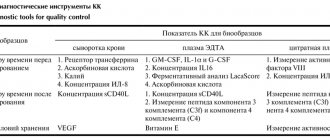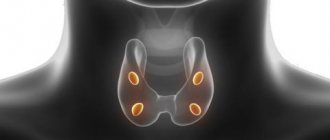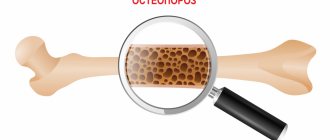Hepatitis
Jaundice
Cervical cancer
Diabetes
52004 03 August
IMPORTANT!
The information in this section cannot be used for self-diagnosis and self-treatment.
In case of pain or other exacerbation of the disease, diagnostic tests should be prescribed only by the attending physician. To make a diagnosis and properly prescribe treatment, you should contact your doctor. We remind you that independent interpretation of the results is unacceptable; the information below is for reference only.
Total protein (in blood) (Protein total): indications for prescription, rules for preparing for the test, interpretation of results and normal indicators.
Indications for prescribing the study
Determining the level of total protein in the blood is recommended as a screening test to look for metabolic disorders of carbohydrates, proteins, fats and microelements, which affects the function of the liver, pancreas, kidneys, etc. A change in the concentration of total protein in the blood may indicate poor nutrition , the presence of acute and chronic inflammatory diseases, oncological processes.
The concentration of total protein may change in the following diseases and conditions:
- emotional stress;
- intense physical activity;
- lack or excess of fluid in the body;
- eating disorders;
- acute and chronic infectious processes;
- prolonged increase in body temperature;
- after operations;
- against the background of extensive burns;
- liver diseases: hepatitis (liver inflammation due to infection with viruses or exposure to toxic substances), cirrhosis;
- chronic autoimmune diseases, as a result of which the immune system attacks the cells of its own body (systemic lupus erythematosus, rheumatoid arthritis, etc.);
- oncological diseases in which abnormal immunoglobulins are produced (proteins with an altered chemical structure, molecular weight or immunological properties).
What is C-reactive protein
h22,0,0,0,0—>
In the results of blood biochemistry, among the protein indicators, you can find a separate type of protein - C-reactive protein (abbreviated as CRP or CRP). This substance belongs to the acute phase proteins or dominant proteins, which are produced at an accelerated rate during damage to body tissues and the development of inflammatory reactions. The protein mobilizes the immune system to fight foreign antigens and activates defense mechanisms. Today it is considered to be a marker of inflammation in the body, much more sensitive than ESR. When a pathological process develops in tissues, the concentration of C-reactive protein quickly increases tenfold.
p, blockquote8,0,0,0,0—>
Preparation for the procedure
Before studying the concentration of total protein and protein fractions, it is necessary to avoid intense physical activity, drink alcohol, and discuss the use of hormonal medications with your doctor.
No. 28Proteins and amino acids
Total protein (in blood) (Protein total) Synonyms: Total protein of blood serum; Total whey protein. Total Protein; Serum Total Protein; Total Serum Protein; TProt; TR. Brief characteristics of the substance being determined Total protein Blood serum (blood plasma devoid of fibrinogen) contains many proteins that perform various...
Up to 1 business day
315 RUR
Period of execution
analysis – 1 working day.
How to make up for protein deficiency
If protein deficiency was not caused by nutritional factors, then primary attention should be directed to the cause leading to their difficult breakdown and absorption. It is the elimination of this etiological factor that will provide the body with a sufficient amount of proteins - otherwise, everything eaten simply will not be absorbed.
As a rule, the leading role is occupied by hypochlorhydria - a decrease in the secretion of hydrochloric acid by the parietal cells of the stomach. If its cause is a violation of the folate cycle, it is worth starting to work with it, taking a course of active forms of vitamins involved in its mechanisms:
- methylfolate;
- methylcobalamin;
- riboflavin 5-phosphate;
- pyridoxal 5-phosphate.
Provided there is no damage to the gastric mucosa, you can also consider the use of dietary supplements that stimulate the secretion of hydrochloric acid:
- Betaine-pepsin.
- Iodine, chlorine and zinc.
In addition, exposure to stress factors that lead to vasospasm should be reduced or completely eliminated. Increase the tone of the parasympathetic system: as you know, it is the vagus nerve that controls the digestive processes. Take baths with magnesium salts, do relaxing practices like Pilates, yoga, breathing exercises.
Suitable as adaptogens for reducing cortisol levels:
:
- Rhodiola rosea;
- valerian;
- ginseng.
We recommend
“Enzyme deficiency: symptoms and treatment” Read more
Lifestyle changes play a key role in normalizing the condition of the entire body. Move more - let 10,000 steps become not something supernatural for you, but a familiar, everyday norm. Eliminate simple sugars from your diet as much as possible: especially if the cause of impaired secretion of digestive juices lies in the syndrome of excessive fungal or bacterial growth.
Go to bed early: at 11 p.m., the secretion of melatonin, an antioxidant hormone responsible for youth, beauty and actively counteracting the development of oxidative stress, begins. In addition, the release of other, no less important hormones: TSH and somatotropin is also tied to the sleep-wake cycle.
What may affect the results
Total protein
levels increase with prolonged tourniquet pressure during blood collection.
A decrease in the concentration of total protein and a change in the ratio of protein fractions occurs in the third trimester of pregnancy against the background of an increase in blood volume and its dilution.
You can donate blood to determine the level of total protein (Protein total) at the nearest INVITRO medical office. A list of offices where biomaterial is accepted for laboratory testing is presented in the “Addresses” section.
Interpretation of study results contains information for the attending physician and is not a diagnosis. The information in this section should not be used for self-diagnosis or self-treatment. The doctor makes an accurate diagnosis using both the results of this examination and the necessary information from other sources: medical history, results of other examinations, etc.
Proteins play a huge role in the human body. They are the main structural unit of the cell, perform many functions (mechanical, catalytic, signaling), and transport various substances. Proteins are based on hormones, enzymes that affect the rate of biochemical reactions, and immunoglobulins that protect the body from infections.
Total blood protein is the sum of all protein fractions in the blood.
They maintain colloid-osmotic pressure and thereby a constant blood volume, bind and retain water, preventing it from leaving the bloodstream, participate in ensuring acid-base balance and blood clotting, transport various inorganic and organic substances, bind macro- and microelements, and participate in in immune response reactions, etc.
The starting material for the construction of protein molecules are amino acids, which enter the body with food. The main plasma proteins are synthesized in liver cells, with the exception of immunoglobulins, which are produced in plasma cells (plasmocytes) and lymphocytes.
Symptoms of protein deficiency in the body
One of the most striking manifestations of insufficient intake and/or absorption of proteins is the appearance of edema. Their development is associated with a naturally occurring failure of water-salt metabolism: under conditions of reduced concentration of proteins in the blood plasma, which normally retain water, the latter passes into the tissues, which is accompanied by their subsequent swelling.
In addition, given the huge role of proteins in creating the skeleton, framework of all cells and organs, their deficiency leads to disruption of tissue structure: brittle hair and nails are noted, and the quality of the skin deteriorates.
Along with the plastic function, this class of organic compounds also performs a catalytic one. A decrease in peptide content leads to a decrease in enzyme activity. In essence, this is a real transport collapse on the highways of metabolism: it slows down and becomes sluggish.
A wide range of hormones also have a protein nature - the endocrine system begins to suffer no less than everyone else. Characteristic: absence of menstruation, decreased production of thyroid hormones (which adds fuel to the already weak fire of barely occurring metabolic processes), slowdown in growth and development due to inhibition of the pituitary gland's synthesis of tropic hormones - including somatotropin.
The lack of amino acids causes proteolysis of tissue proteins - there is a decrease in muscle mass, its tone and strength.
In other words, there is no organ that is not affected by protein deficiency - total dysfunction progresses at all levels of functioning: from molecular to organismal.
Reference values for total protein
| Age | Women, g/l | Men, g/l |
| 1 day – 4.3 weeks | 42–62 | 41–63 |
| 4.3 weeks – 6 months | 44–66 | 47–67 |
| 6–12 months | 56–79 | 55–70 |
| 12–24 months | 56–75 | 56–75 |
| 24 months – 14 years | 60–80 | 60–80 |
| 14–60 years | 64–83 | 64–83 |
| > 60 years | 62–81 | 62–81 |
This is a measurement of the concentration of total protein (albumin + globulins) in the liquid part of the blood, the results of which characterize the metabolism of proteins in the body.
Synonyms Russian
Total protein, total serum protein.
English synonyms
Total Protein, Serum Total Protein, Total Serum Protein, TProt, TR.
Research method
Colorimetric photometric method.
Units
G/L (grams per liter).
What biomaterial can be used for research?
Venous, capillary blood.
How to properly prepare for research?
- Do not eat for 12 hours before the test.
- Avoid physical and emotional stress 30 minutes before the test.
- Do not smoke for 30 minutes before the test.
General information about the study
The total protein content in blood serum reflects the state of protein metabolism.
Proteins predominate in the solid residue of blood serum (the liquid part that does not contain cellular elements). They serve as the main building material for all cells and tissues of the body. Enzymes, many hormones, antibodies and blood clotting factors are built from proteins. In addition, they function as carriers of hormones, vitamins, minerals, fat-like substances and other metabolic components in the blood, and also ensure their transport into cells. The amount of proteins in the serum determines the osmotic pressure of the blood, which maintains a balance between the water content in the body tissues and inside the vascular bed. It determines the ability of water to be retained in the circulating blood and maintain tissue elasticity. Proteins are also responsible for ensuring proper acid-base balance (pH). Finally, it is a source of energy during malnutrition or starvation.
Serum proteins are divided into two classes: albumins and globulins. Albumin is synthesized in the liver from food. Their amount in the plasma affects the level of osmotic pressure, which holds fluid inside the blood vessels. Globulins perform an immune function (antibodies), ensure normal blood clotting (fibrinogen), and are also represented by enzymes, hormones and carrier proteins of various biochemical compounds.
A deviation in the level of total blood protein from the norm can be caused by a number of physiological conditions (not of a pathological nature) or be a symptom of various diseases. It is customary to distinguish between a relative deviation (associated with changes in the water content in the circulating blood) and an absolute deviation (caused by changes in the metabolism - the rate of synthesis / breakdown - of serum proteins).
- Physiological absolute hypoproteinemia can occur during prolonged bed rest, in women during pregnancy (especially in the last third) and breastfeeding, in children at an early age, that is, in conditions of insufficient protein intake from food or an increased need for it. In these cases, the total protein level in the blood decreases.
- The development of physiological relative hypoproteinemia (decrease in the level of total protein in the blood) is associated with excess fluid intake (increased water load).
- Relative hyperproteinemia (increased levels of total protein in the blood) can be caused by excess water loss, such as during profuse sweating.
- Relative pathological (associated with any disease) hyperproteinemia is caused by significant loss of fluid and blood thickening (with profuse vomiting, diarrhea or chronic nephritis).
- Pathological relative hypoproteinemia is observed in the opposite cases - with excessive fluid retention in the circulating blood (impaired kidney function, deterioration of heart function, some hormonal disorders, etc.).
- An absolute increase in total blood protein can occur in acute and chronic infectious diseases due to increased production of immune globulins, in some rare health disorders characterized by intense synthesis of abnormal proteins (paraproteins), in liver diseases, etc.
Absolute hypoproteinemia is of greatest clinical importance. An absolute decrease in the concentration of total protein in the blood most often occurs due to a decrease in the amount of albumin. A normal level of albumin in the blood is an indicator of good health and proper metabolism, and conversely, a low level indicates low vitality of the body. At the same time, the loss/destruction/insufficient synthesis of albumin is a sign and indicator of the severity of some diseases. Thus, an analysis of total blood protein makes it possible to identify a significant decrease in the vitality of the body due to any important health reasons or to take the first step in diagnosing a disease associated with a disorder of protein metabolism.
Depletion of albumin reserves in the blood can occur due to malnutrition, diseases of the gastrointestinal tract and difficulties in digesting food, chronic intoxication.
Diseases associated with a decrease in the amount of blood albumin include some disorders in the liver (decreased protein synthesis in it), kidneys (loss of albumin in the urine as a result of a violation of the blood filtration mechanism in the kidneys), certain endocrine disorders (disturbances in the hormonal regulation of protein metabolism) .
What is the research used for?
- As part of the first stage of a comprehensive examination in the process of diagnosing various health disorders.
- To identify and assess the severity of nutritional disorders (in case of intoxication, malnutrition, diseases of the gastrointestinal tract).
- For the purpose of diagnosing various diseases associated with protein metabolism disorders and to evaluate the effectiveness of their treatment.
- To monitor physiological functions during long-term clinical observations.
- To assess the functional reserves of the body in connection with the prognosis for the current disease or upcoming treatment procedures (drug therapy, surgery).
When is the study scheduled?
- During the initial diagnosis of any disease.
- For symptoms of exhaustion.
- If you suspect a disease associated with any disorders of protein metabolism.
- When assessing the state of metabolism or the thyroid gland.
- When examining liver or kidney function.
- With long-term clinical monitoring of the treatment of diseases associated with protein metabolism disorders.
- When surgery is being considered.
- During a preventive examination.
What do the results mean?
Reference values (normal total protein in the blood)
| Age | Reference values |
| 0 - 7 months | 44 – 76 g/l |
| 7 - 12 months | 51 - 73 g/l |
| 1 – 3 years | 56 - 75 g/l |
| 3 – 18 years | 60 - 80 g/l |
| > 18 years old | 64 – 83 g/l |
The results of the analysis of total protein in the blood serum allow us to assess the state of health, nutrition and the function of internal organs based on the effectiveness of their work in maintaining normal protein metabolism. If a deviation from the norm is detected, further examination is required to clarify its cause.
Reasons for increased levels of total protein in the blood
- Acute and chronic infection (including tuberculosis),
- dysfunction of the adrenal cortex,
- autoimmune diseases (rheumatoid arthritis, systemic lupus erythematosus, scleroderma),
- allergic conditions,
- some rare systemic diseases,
- loss of fluid (diabetic acidosis, chronic diarrhea, etc.),
- respiratory failure,
- destruction of red blood cells,
- active chronic hepatitis,
- some rare blood diseases.
Reasons for decreased levels of total protein in the blood
- Fluid retention due to impaired renal function or weakened heart function,
- insufficient intake of protein into the body or impaired absorption of food in the gastrointestinal tract (due to fasting, malnutrition, narrowing of the esophagus, inflammatory bowel diseases),
- decreased protein synthesis in the liver (due to hepatitis, cirrhosis/liver atrophy, intoxication),
- congenital disorders of the synthesis of certain blood proteins,
- increased protein breakdown (as a result of malignant neoplasms, hyperfunction of the thyroid gland, postoperative conditions, prolonged fever, trauma, long-term treatment with hormonal anti-inflammatory drugs),
- excessive protein loss due to kidney disease, diabetes, bleeding,
- loss of protein along with fluid that accumulates in the abdominal cavity and pleura.
What can influence the result?
Eating can significantly increase the protein content in the blood, while after exercise it decreases. Protein concentration can also be affected by the consumption of tea, coffee, alcohol, and medications. In addition, for the most accurate results, the patient should refrain from eating foods with significant amounts of fat.
Interpretation of results in children and adults
An increase in the concentration of total protein (hyperproteinemia) can be observed:
- against the background of intense physical activity (due to the breakdown of muscle proteins and their release into the blood);
- due to dehydration: due to lack of water intake or loss of a large volume of fluid in diseases and conditions accompanied by uncontrollable vomiting, diarrhea, increased sweating, excessive urination;
- with increased protein synthesis against the background of chronic systemic inflammatory diseases, autoimmune processes, including due to an increase in the amount of antibodies (immunoglobulins), with chronic non-infectious hepatitis (for example, with alcohol intoxication). The reason for the persistent increase in the content of total protein in the blood is malignant diseases (myeloma, macroglobulinemia), in which plasma cells produce pathological (not normally found) proteins similar to immunoglobulins.
A decrease in the concentration of total protein in the blood (hypoproteinemia) is observed when:
- insufficient intake, improper breakdown or impaired absorption of proteins. This occurs against the background of prolonged fasting, unbalanced nutrition, inflammatory diseases of the gastrointestinal tract (enterocolitis - inflammation of the intestines, pancreatitis - inflammation of the pancreas);
- increased consumption or loss of protein (kidney diseases, in which protein enters the urine, protein consumption for the construction of tumor tissue, loss of protein during extensive bleeding);
- chronic diseases (hepatitis, cirrhosis), when the liver loses its ability to synthesize proteins;
- increased breakdown of proteins after operations, against the background of prolonged fever, burns, cancer;
- redistribution and release of protein and fluid from blood vessels during inflammation (with the formation of exudate) and during non-inflammatory processes (with the formation of transudate);
- congenital deficiency of immunoglobulins.
If the indicator deviates from the norm, the following studies are additionally carried out: albumin (in the blood) (Albumin), protein fractions (Serum Protein Electrophoresis, SPE), clinical blood test: general analysis, leukoformula, ESR (with mandatory “manual” microscopy of a blood smear).
Interpretation of results
Norms vary depending on the gender and age of patients. Significant changes in indicators are observed in many physiological conditions (for example, during pregnancy). Minor deviations may be one of the first signs of various diseases, or may not indicate the presence of pathology. When interpreting the results, the doctor takes into account a large number of factors (history, presence of complaints, etc.). If necessary, additional examination is prescribed.
For adult patients, reference values are 64-83 g/l. In children, the norm is determined in accordance with their age. When assessing results, it is necessary to take into account the patient's level of physical activity. The test is not intended for self-diagnosis. Only a doctor can correctly interpret its results.
Table of norms by trimester
| Dates of pregnancy | Indicator as a percentage |
| First trimester | from 78 to 121 |
| Second trimester | from 83 to 133 |
| Third trimester | from 67 to 135 |
What are the dangers of low protein C in the blood of a pregnant woman? The development of deep vein thrombosis in the legs is a fairly common occurrence for pregnant women. A decrease in protein increases the risk of developing blood clots by 10 times.
A deficiency of cells can cause a serious condition in newborns called purpura fulminans, which is the formation of clots that block small blood vessels. This disease often ends in death. This is why regular monitoring during pregnancy is so important.
Symptomatic manifestations of hypoproteinemia
A drop in protein levels is not characterized by clear specific symptoms. Somatic and external manifestations of low protein in the blood depend on the disorders and diseases that provoked changes in blood composition. With a slight loss of proteins, weakness, decreased physical capabilities, and CFS (chronic fatigue syndrome) are observed.
With a more serious decrease in indicators, the following manifestations are added:
- dysania (sleep disorder), apathy, irritability;
- unstable functioning of the digestive and urinary system;
- frequent ARVI and colds;
- labored breathing;
- suppression of libido (sexual desire);
- hypertensive symptoms (increased blood pressure, headache).
An external sign is swelling (accumulation of excess fluid in the extracellular space). Edema occurs due to a violation of the stable level of colloid-osmotic and hydrostatic pressure on the walls of blood vessels, since an insufficient number of protein molecules cannot provide the necessary compression for the passage of water from the tissue fluid into the bloodstream.
A reduced level of protein inhibits the process of formation of new cells, therefore the processes of post-traumatic skin restoration are disrupted. Trying to make up for the lack of proteins, the body begins to pull them from muscle fibers, which leads to their destruction. The symptoms are:
- arthralgia – muscle pain not caused by physical stress or inflammatory processes;
- weight loss (due to muscle mass).
Lack of nutrients affects the health of hair and nails (brittleness, dryness, etc.). Hypoproteinemia can only be determined through a laboratory blood test. To do this, you need to donate blood for a biochemical analysis. Blood sampling is carried out free of charge upon referral from a doctor. You can undergo the procedure yourself for a fee at clinical diagnostic centers.









